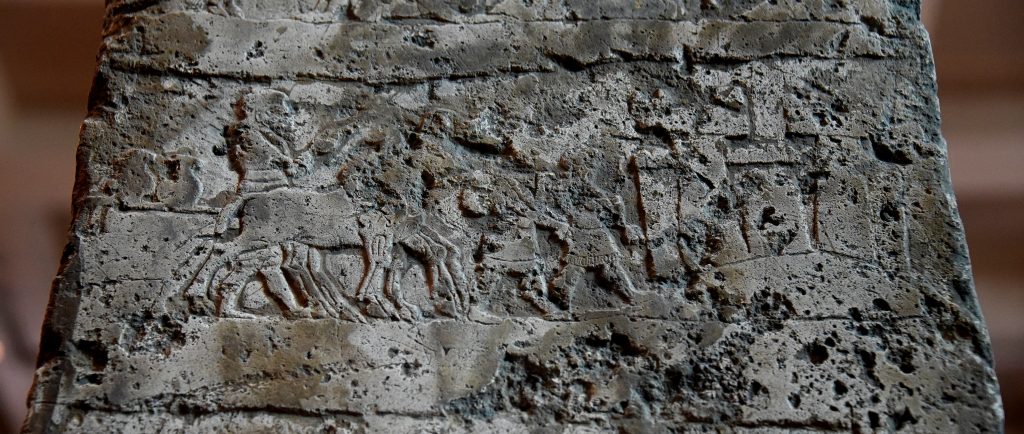In July 1853, Hormuzd Rassam was excavating an area at the ruins of the mound of Kuyunjik (Nineveh, Mesopotamia, modern-day Mosul Governorate, Iraq), one of the most important cities in the heartland of the Assyrian Empire. The area was an open space between the outer court of the palace of the Assyrian King Sennacherib and the Ishtar Temple. About 200 feet northeast of the palace, Rassam dug a trench that went down about 15 feet from the surface of the mound. At this point, his workmen found a large, 4-sided, monolith pillar; it was an obelisk, somewhat whitish in colour. The obelisk was lying on it sides. An artist, C. D. Hodder, who accompanied Rassam on his expedition, made drawings of the 4 sides of the obelisk in situ. It is now known as the White Obelisk of Ashurnasirpal I and housed in the British Museum.

The White Obelisk of Ashurnasirpal I on display within Room 6a of the British Museum. This is side A. Behind it and to the left is the Black Obelisk of Shalmaneser III. On the background and to the right, a Lamassu from the North-West Palace of Ashunasirpal II and a reconstructed Balawat Gate also appear. Assyrian, probably about 1050 BCE. From Mesopotamia, Nineveh (modern-day Mosul Governorate, Iraq), between the palace of Sennacherib and the Ishtar temple. The British Museum, London. Photo © Osama S. M. Amin.
Rassam shipped the obelisk to modern-day Basra Governorate (on the Arabian/Persian Gulf), on the southern end of Iraq. In March 1854, the shipment reached Bombay, India, and from there, the obelisk was transferred to the United Kingdom. On a cold February day in 1855 the Obelisk arrived at London. The British Museum’s registration number was 1856,0909.58 but it is now BM/Big number 118807. The obelisk was cleaned by W. G. Langford, a conservation officer in the Department of Western Asiatic Antiquities, and photographed by the British Museum photographers while still wet.
The obelisk was made of white limestone. It has a height of 285 centimetres, a width of 70.48 centimetres, and a depth of 42.54 centimetres. It is rectangular, with 4 sides. The obelisk tapers gradually from bottom to top; the latter has a ziggurat-like shape. Near the base, there are ancient saw marks. The lower 25-30 centimetres are devoid of any scene or inscriptions but are rough, unfinished, and seemed to be inserted into a pedestal, originally.
Each surface was carved with low-reliefs scenes and divided into 8 horizontal registers; therefore a total of 32 “frames” can be observed. Although the surfaces of the obelisk is considerably weathered and eroded, but fortunately it is still “complete” and did not suffer any deliberate damage (the fate of many other victory monuments of ancient Near Eastern rulers, once their domination was overthrown from without or within). On sides A and D, there are Akkadian cuneiform inscriptions.
Immediately after its discovery, the monument was attributed to the Neo-Assyrian King Ashurnasirpal II (reigned 883-859 BCE). This is because the name of Aššur-nāṣir-apli appeared within the text, admittedly without titles or patronymic. However, the British Museum says that the obelisk belongs to the Assyrian King Ashurnasirpal I (reigned 1049-1031 BCE).
Because the internet does not provide clear-cut, modern colour images of all sides and scenes of the obelisk, I said to myself, why not draft an article about it and share my Nikon710 images with the rest of the world? Therefore, it is beyond this article to discuss whether this monument belongs to Ashurnasirpal I or II. I’m a consultant neurologist, not an archaeologist.
The White Obelisk has had a strange history in the scholarship of Assyria. In studies of Assyrian art it has either been ignored or described as a crude work with sketchy representations arranged in an incomprehensible composition, the product of an incompetent craftsman. The inscription, on the other hand, has been frequently discussed, always in regard to the critical problem of its date. The King is shown in his chariot, fighting (upper registers) and hunting (lower registers), and taking part in ritual ceremonies. The middle scenes show booty and tribute being brought, but their order is uncertain. This is an early example of Assyrian narrative reliefs that developed into the palace reliefs of later periods.
The obelisk is on display and is erected within Room 6a, beside the Black Obelisk of Shalmaneser III. When you stand in front of the obelisk to read the accompanying description, you will be facing Side C; the Kurkh monoliths are immediately behind you. The obelisk stands within one of the corners of a platform. Therefore, it is easy to see and take photos of sides C and D; sides A and B would be far away from view and you needs a good zooming lens, like mine; AF-S Nikkor 28-300 mm f/3.5-5.6 G ED VR.
Unlike the Black Obelisk of Shalmaneser III (which bears a figure of an ancient ruler of Israel, Jehu, who was mentioned in the Bible and therefore drew the attention of the world), this White Obelisk seems to be overlooked by many museum visitors, social media, and even Flickr. In addition, the owner of the White Obelisk is controversial (Ashurnasirpal I or II?). I stood after shooting all faces of the Obelisk and observed those who approached the platform on which the White and Black Obelisks were displayed. I watched visitors for about 15 minutes. Noone shot a single photo of the White Obelisk, and surprisingly, there was no eye contact with it, either. I asked three different people (from South East Asia, Eastern Europe, and North America, respectively), who were very close to the White Obelisk about it. Their answers were: “I did not notice it;” “It is just a dull-colored block of stone, nothing is interesting about it;” and finally “I don’t know, maybe because it is within a crowd of monuments”.
I searched out the internet in order to find images and fine details of the White Obelisk (zoomed-in, very close shots, not an image of the Obelisk as a whole), which can be easily accessible by the public, students and activists. But I found only 2 images on an archival website, with a large watermark on both of these pics. On the other hand, I read a few scholarly articles about the White Obelisk and all of the images of the White Obelisk within the articles were “Photos of the British Museum.”
Therefore, and because this wonderful monument was brought from my land, Mesopotamia/Iraq, and because of the lack of modern high-quality images that can be reached by anyone, I decided to document all aspects of the White Obelisk, using a superb camera and lens. Yes, we all agree that the surfaces and frames of the scenes were eroded and weathered, and that it is difficult to enjoy the art of it, but who knows…maybe someone…after 1, 10, or perhaps 100 years will find my pictures invaluable for his work.
Now, enjoy the scenes. The surfaces of sides B and D are narrower than those of A and C. I will describe the scenes and registers, horizontally, from top to bottom.
Register 1: There are 4 scenes, when combined all together, they form a single horizontal frame.
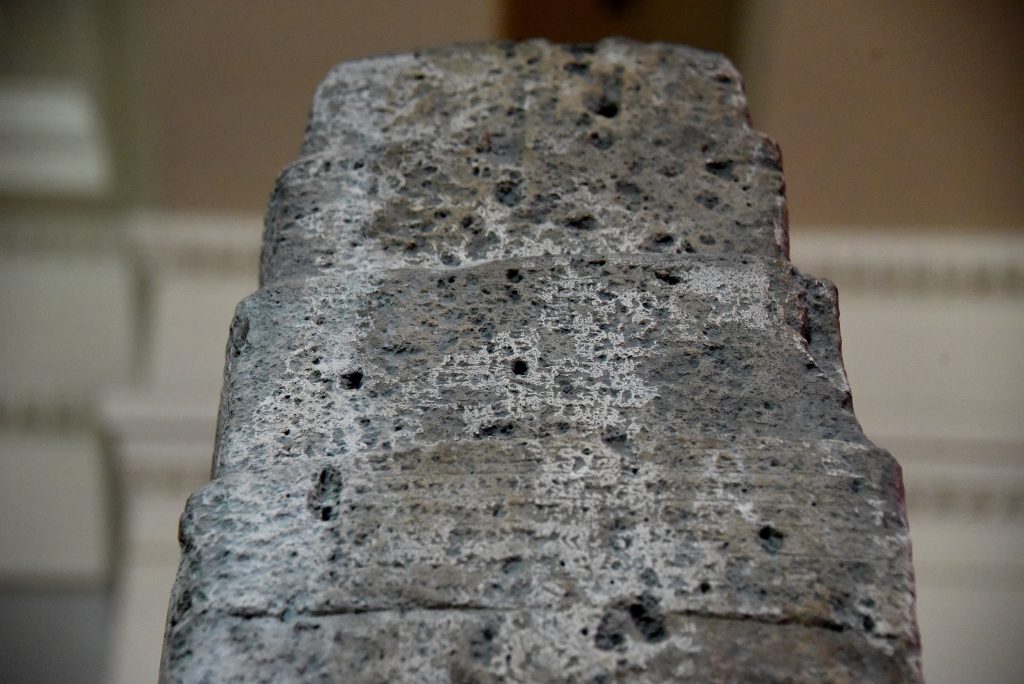
Top of side D. Detail of the White Obelisk of Ashurnasirpal I. The ziggurat-like top of the obelisk. There are Akkadian cuneiform inscriptions on the lower 2 blocks of the steps; the text is the 2nd column of the whole inscription; the 1st column lies on the upper part of side A. Assyrian, probably about 1050 BCE. From Mesopotamia, Nineveh (modern-day Mosul Governorate, Iraq), between the palace of Sennacherib and the Ishtar temple. The British Museum, London. Photo © Osama S. M. Amin.
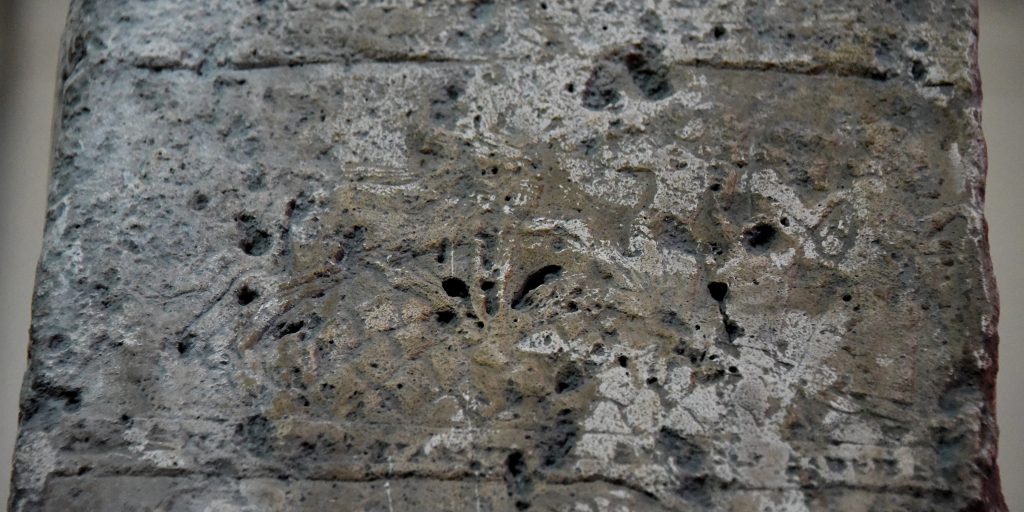
Frame 1D: Here, the figures of the king and two kinsmen appear to walk on a mountain in front of a royal chariot. A single figure follows behind. At the extreme left side of frame 1A (shown below), there is a single standing figure faces towards this group which descends the mountain. Detail of the White Obelisk of Ashurnasirpal I. Assyrian, probably about 1050 BCE. From Mesopotamia, Nineveh (modern-day Mosul Governorate, Iraq), between the palace of Sennacherib and the Ishtar temple. The British Museum, London. Photo © Osama S. M. Amin.
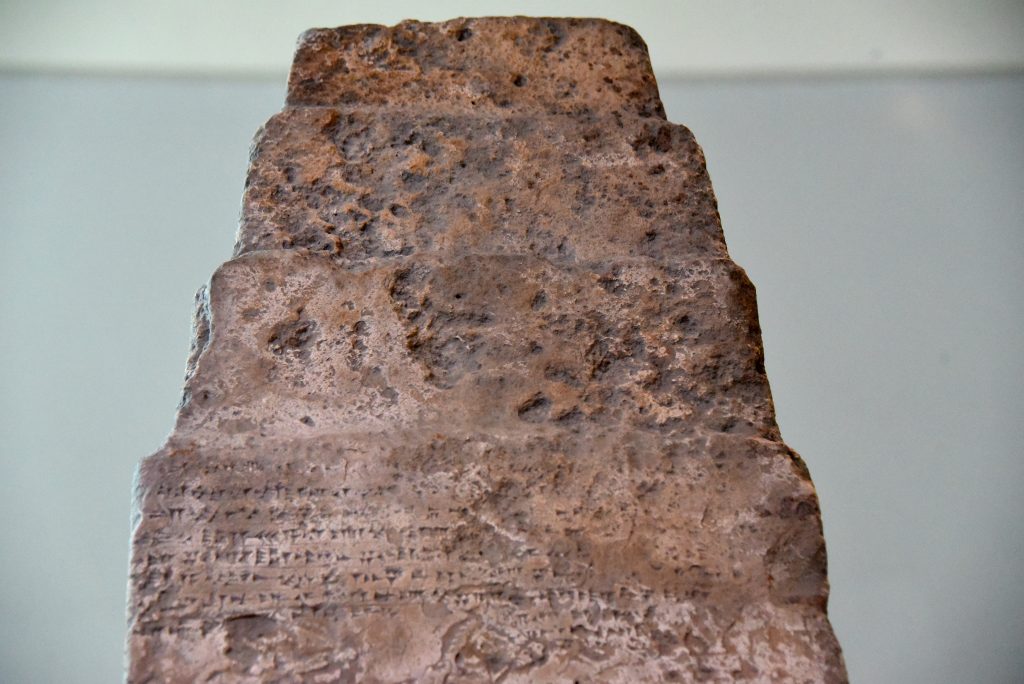
Top of side A. Detail of the White Obelisk of Ashurnasirpal I. There are Akkadian cuneiform inscriptions on the lowest block of this ziggurat-like top. This is the column or text A of the inscriptions. Assyrian, probably about 1050 BCE. From Mesopotamia, Nineveh (modern-day Mosul Governorate, Iraq), between the palace of Sennacherib and the Ishtar temple. The British Museum, London. Photo © Osama S. M. Amin.
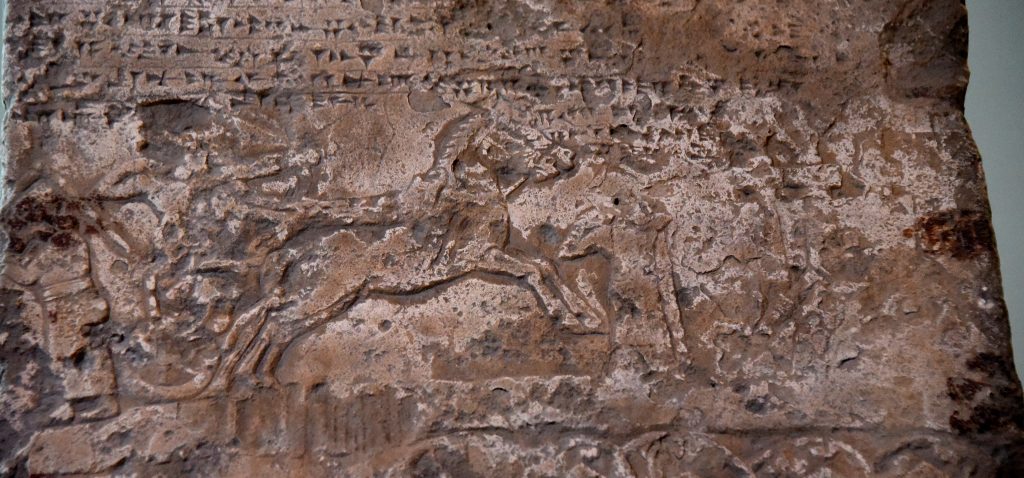
Frame 1A: The king within his royal chariot rides towards the right side. Before the king, there are two standing archers, who take aim at a city. The city and its walls appear on a mound. Detail of the White Obelisk of Ashurnasirpal I. Assyrian, probably about 1050 BCE. From Mesopotamia, Nineveh (modern-day Mosul Governorate, Iraq), between the palace of Sennacherib and the Ishtar temple. The British Museum, London. Photo © Osama S. M. Amin.
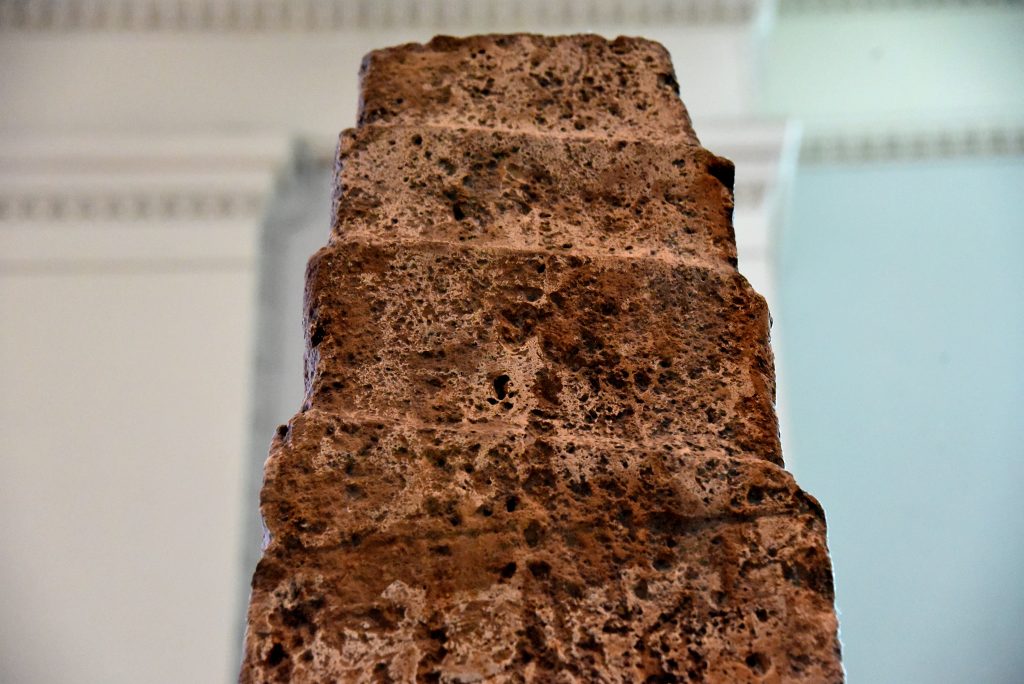
Top of side B, which does not contain any cuneiform inscription. Detail of the White Obelisk of Ashurnasirpal I. Assyrian, probably about 1050 BCE. From Mesopotamia, Nineveh (modern-day Mosul Governorate, Iraq), between the palace of Sennacherib and the Ishtar temple. The British Museum, London. Photo © Osama S. M. Amin.
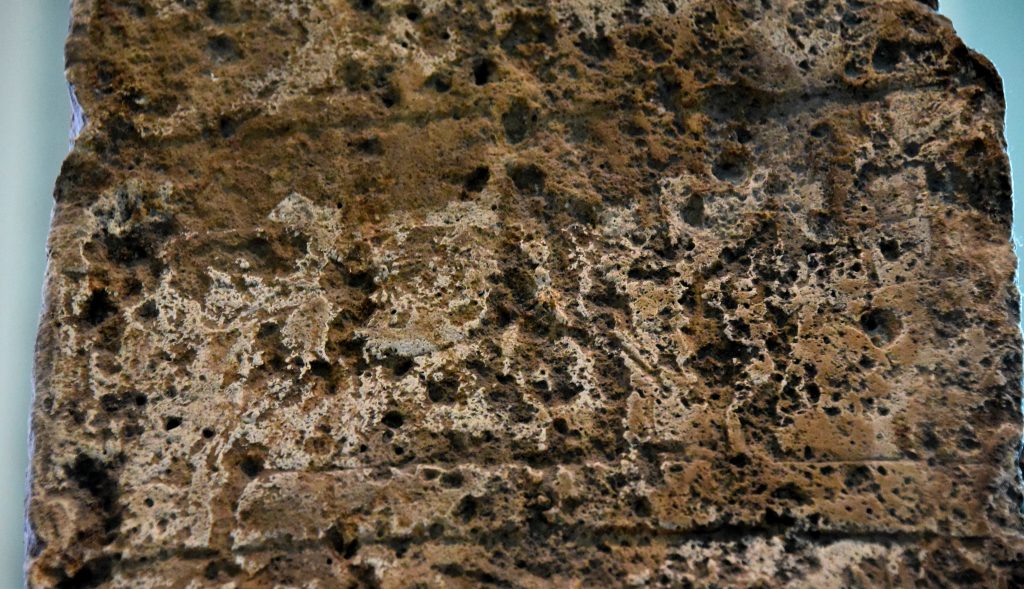
Frame 1B: This seems to be a virtual repetition of frame 1A. The length of this frame appears to be shorter; however, this was accommodated by overlapping. Detail of the White Obelisk of Ashurnasirpal I. Assyrian, probably about 1050 BCE. From Mesopotamia, Nineveh (modern-day Mosul Governorate, Iraq), between the palace of Sennacherib and the Ishtar temple. The British Museum, London. Photo © Osama S. M. Amin.
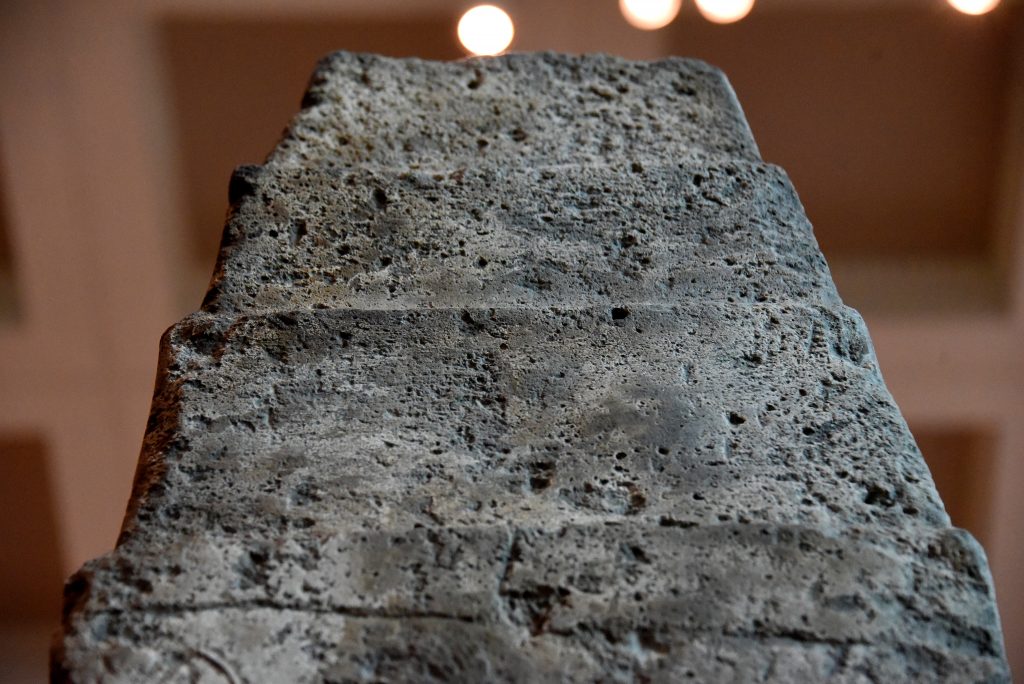
Top of side C. This upper end of the obelisk, similar to that of side B, lacks cuneiform texts. Detail of the White Obelisk of Ashurnasirpal I. Assyrian, probably about 1050 BCE. From Mesopotamia, Nineveh (modern-day Mosul Governorate, Iraq), between the palace of Sennacherib and the Ishtar temple. The British Museum, London. Photo © Osama S. M. Amin.
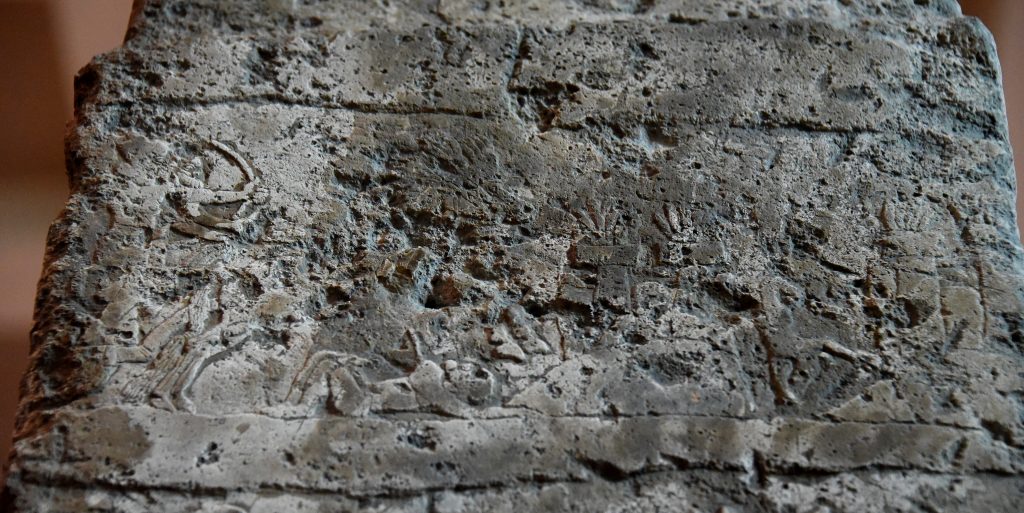
Frame 1C: The king within his royal chariot moves forward and approaches 2 cities. Each city lies on a hill or mound. A figure of an enemy soldier appears under the rearing horses. Detail of the White Obelisk of Ashurnasirpal I. Assyrian, probably about 1050 BCE. From Mesopotamia, Nineveh (modern-day Mosul Governorate, Iraq), between the palace of Sennacherib and the Ishtar temple. The British Museum, London. Photo © Osama S. M. Amin.
Register 2: We have 4 frames but one can recognise 3 scenes, actually. Two of them are forming single episodes, each one frame in length; one is a single episode which has extended over two frames.
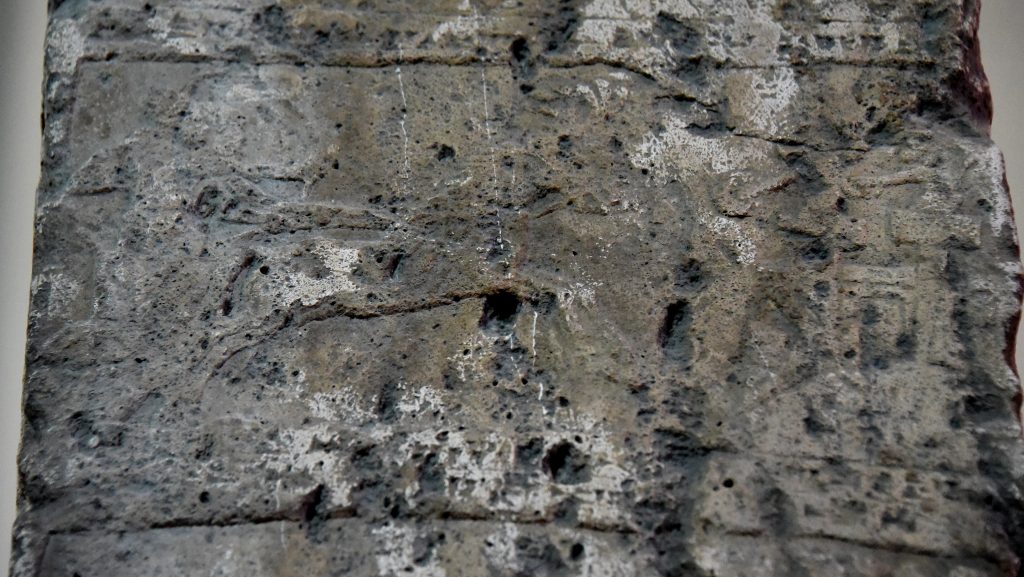
Frame 2D: This appears to be a repetition of frame 1A. Detail of the White Obelisk of Ashurnasirpal I. Assyrian, probably about 1050 BCE. From Mesopotamia, Nineveh (modern-day Mosul Governorate, Iraq), between the palace of Sennacherib and the Ishtar temple. The British Museum, London. Photo © Osama S. M. Amin.
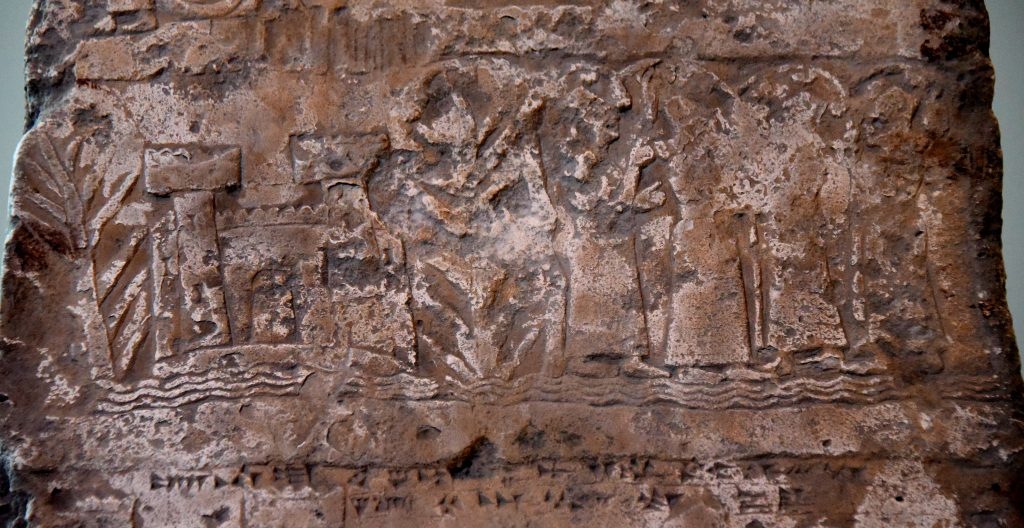
Frame 2A: This should be combined with frame 2B in order to understand what had been depicted, as a whole single frame/scene. There is an outdoor ceremony, under an arbor of trees, adjacent to a river. Six ranks of men appear to move forward and approach the figure of the King and his courtiers. To the left side, there is a city which is flanked by trees and stands on a low mound. A similar tree marks the end of the scene to the extreme right side of the frame. Detail of the White Obelisk of Ashurnasirpal I. Assyrian, probably about 1050 BCE. From Mesopotamia, Nineveh (modern-day Mosul Governorate, Iraq), between the palace of Sennacherib and the Ishtar temple. The British Museum, London. Photo © Osama S. M. Amin.

Frame 2B: This should be combined with frame 2A in order to understand what is had been depicted, as a whole single frame/scene. There is an outdoor ceremony, under an arbor of trees, adjacent a river. Six ranks of men appear to move forward and approach the figure of the King and his courtiers. To the left side, there is a city which is flanked by trees and stands on a low hill. A similar tree marks the end of the scene to the extreme right side of the frame (in this eroded image). Detail of the White Obelisk of Ashurnasirpal I. Assyrian, probably about 1050 BCE. From Mesopotamia, Nineveh (modern-day Mosul Governorate, Iraq), between the palace of Sennacherib and the Ishtar temple. The British Museum, London. Photo © Osama S. M. Amin.
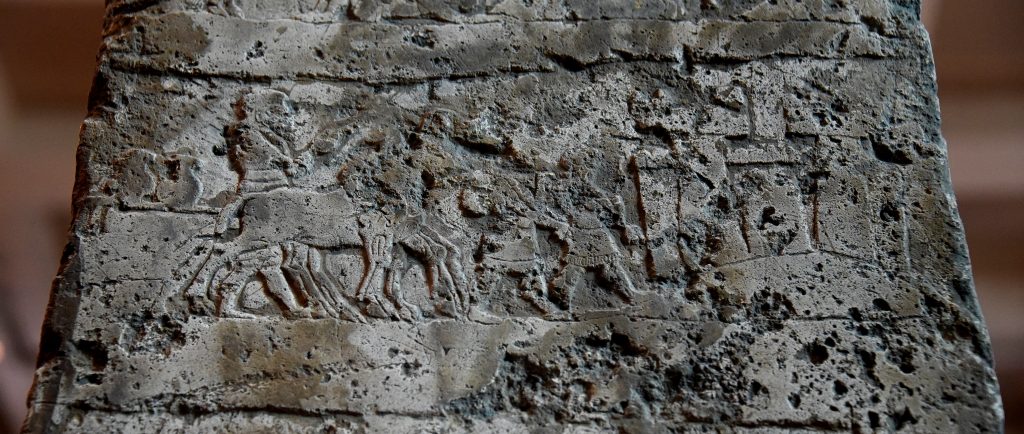
Frame 2C: On this frame, there are soldiers and horses which appear to move forward to the right and approach a city. The city lies on a low mound. Behind the soldiers, we can recognise a laden table. Detail of the White Obelisk of Ashurnasirpal I. Assyrian, probably about 1050 BCE. From Mesopotamia, Nineveh (modern-day Mosul Governorate, Iraq), between the palace of Sennacherib and the Ishtar temple. The British Museum, London. Photo © Osama S. M. Amin.
Register 3: We can recognise 2 separate scenes. One scene constitutes a single episode which was depicted within one frame. The other scene is composed of two episodes, extending over 3 frames.
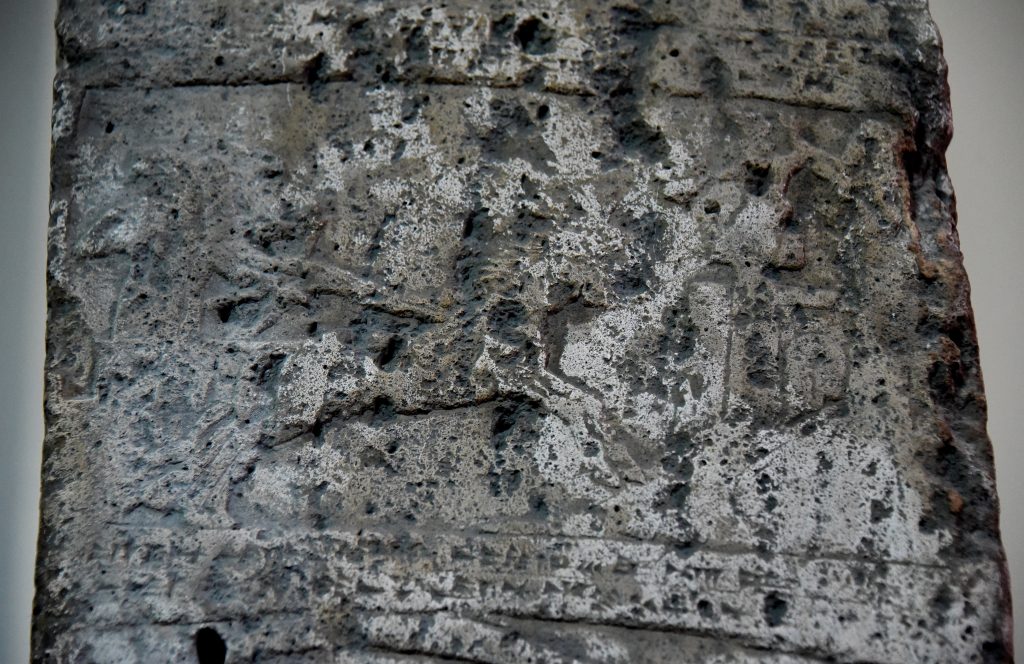
Frame 3D: Once again, this frame is a repetition of frame 1A. Detail of the White Obelisk of Ashurnasirpal I. Assyrian, probably about 1050 BCE. From Mesopotamia, Nineveh (modern-day Mosul Governorate, Iraq), between the palace of Sennacherib and the Ishtar temple. The British Museum, London. Photo © Osama S. M. Amin.
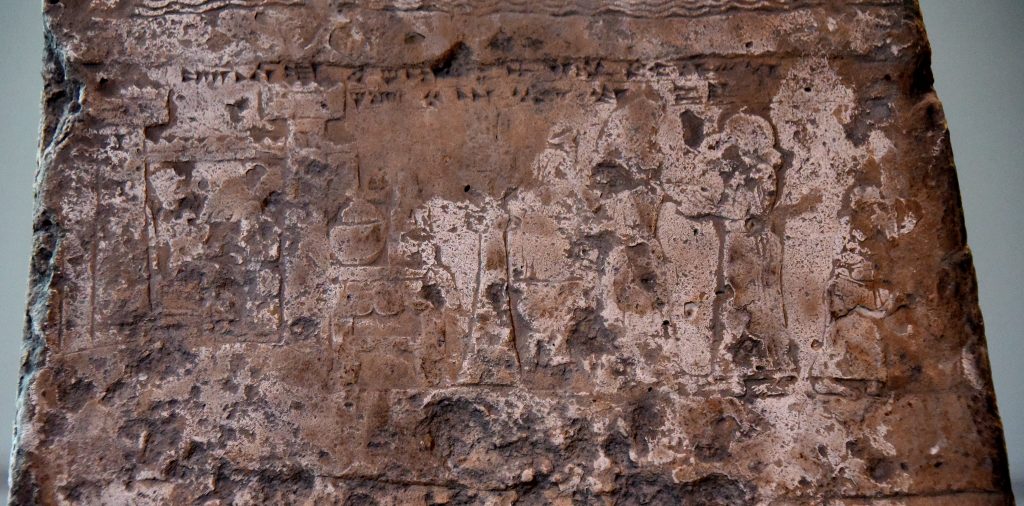
Frame 3A. Frames 3A, 3B, and 3C should be combined altogether to formulate the whole episode. The depiction should be inspected from right to left. The first episode runs over one-and-a-half frames. In front of a table, the King sits under a baldachin, outdoors (in this image). One of the King’s courtier stands directly before him. In two registers, to the right, we can recognise individuals sitting facing each other, while other figures stand in front of laden tables. In the second episode, 2 ranks of men stand behind a bull; the bull appears to be brought to sacrifice. The depiction of the body of the animal is divided between frames 3B and 3A. In front, the King, who is accompanied by a servant, approaches a cultic apparatus in front of a building on a low mound. Inside this structure, the King stands without his headgear before a seated goddess. Above the scene is the epigraph quoted above designating the scene as a ritual for the goddess Ishtar (this is shown in this image). Detail of the White Obelisk of Ashurnasirpal I. Assyrian, probably about 1050 BCE. From Mesopotamia, Nineveh (modern-day Mosul Governorate, Iraq), between the palace of Sennacherib and the Ishtar temple. The British Museum, London. Photo © Osama S. M. Amin.
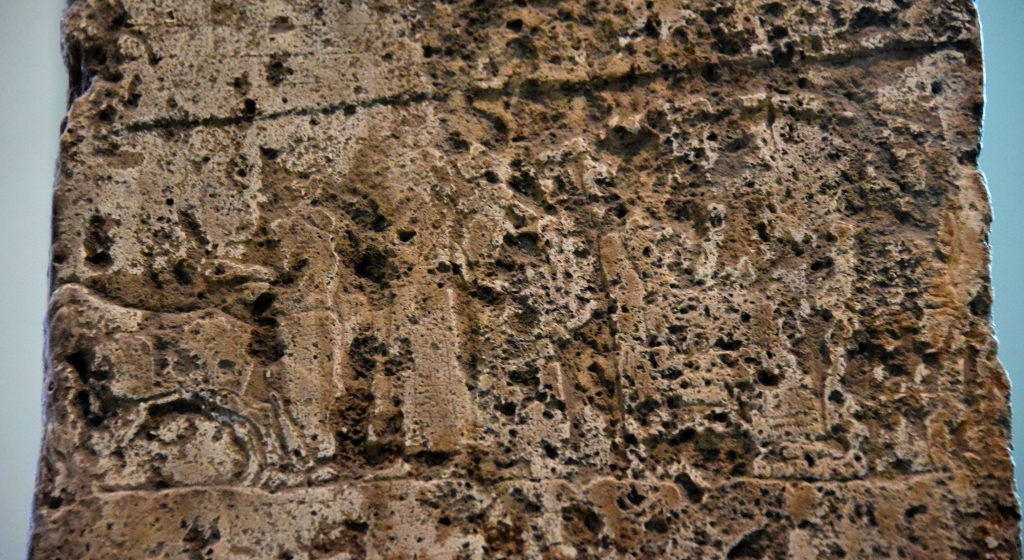
Frame 3B. Frames 3A, 3B, and 3C should be combined altogether to formulate the whole episode. The depiction is skimmed from right to left. The first episode runs over one-and-a-half frames. In front of a table, the King sits under a baldachin, outdoors. One of the King’s courtier stands directly before him. In two registers, to the right, we can recognise individuals sitting facing each other, while other figures stand in front of laden tables. In the second episode, 2 ranks of men stand behind a bull; the bull appears to be brought to sacrifice. The depiction of the body of the animal is divided between frames 3B and 3A (the body of the bull can be seen on the far left side of this image). In front, the King, who is accompanied by a servant, approaches a cultic apparatus in front of a building on a low mound. Inside this structure, the King stands without his headgear before a seated goddess. Above the scene is the epigraph quoted above designating the scene as a ritual for the goddess Ishtar. Detail of the White Obelisk of Ashurnasirpal I. Assyrian, probably about 1050 BCE. From Mesopotamia, Nineveh (modern-day Mosul Governorate, Iraq), between the palace of Sennacherib and the Ishtar temple. The British Museum, London. Photo © Osama S. M. Amin.
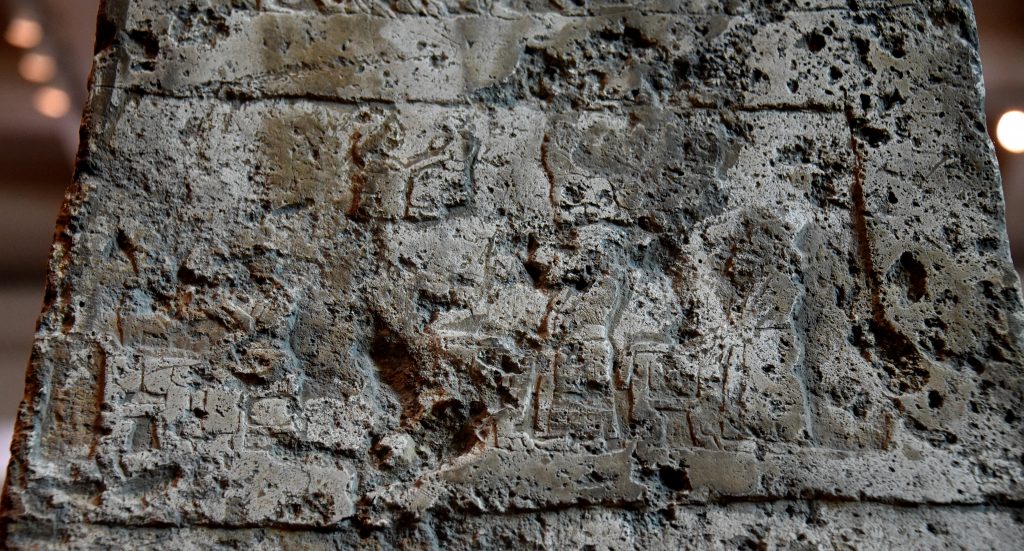
Frame 3C. Frames 3A, 3B, and 3C should be combined altogether to formulate the whole episode. The depiction is skimmed from right to left. The first episode runs over one-and-a-half frames. In front of a table, the King sits under a baldachin, outdoors. One of the King’s courtier stands directly before him. In two registers, to the right, we can recognise individuals sitting facing each other, while other figures stand in front of laden tables (this is shown in this image). In the second episode, 2 ranks of men stand behind a bull; the bull appears to be brought to sacrifice. The depiction of the body of the animal is divided between frames 3B and 3A. In front, the King, who is accompanied by a servant, approaches a cultic apparatus in front of a building on a low mound. Inside this structure, the King stands without his headgear before a seated goddess (appears in this image). Above the scene is the epigraph quoted above designating the scene as a ritual for the goddess Ishtar. Detail of the White Obelisk of Ashurnasirpal I. Assyrian, probably about 1050 BCE. From Mesopotamia, Nineveh (modern-day Mosul Governorate, Iraq), between the palace of Sennacherib and the Ishtar temple. The British Museum, London. Photo © Osama S. M. Amin.
Register 4: We can recognise 1 scene, which occupies all four frames (4D, 4A, 4B, and 4C).
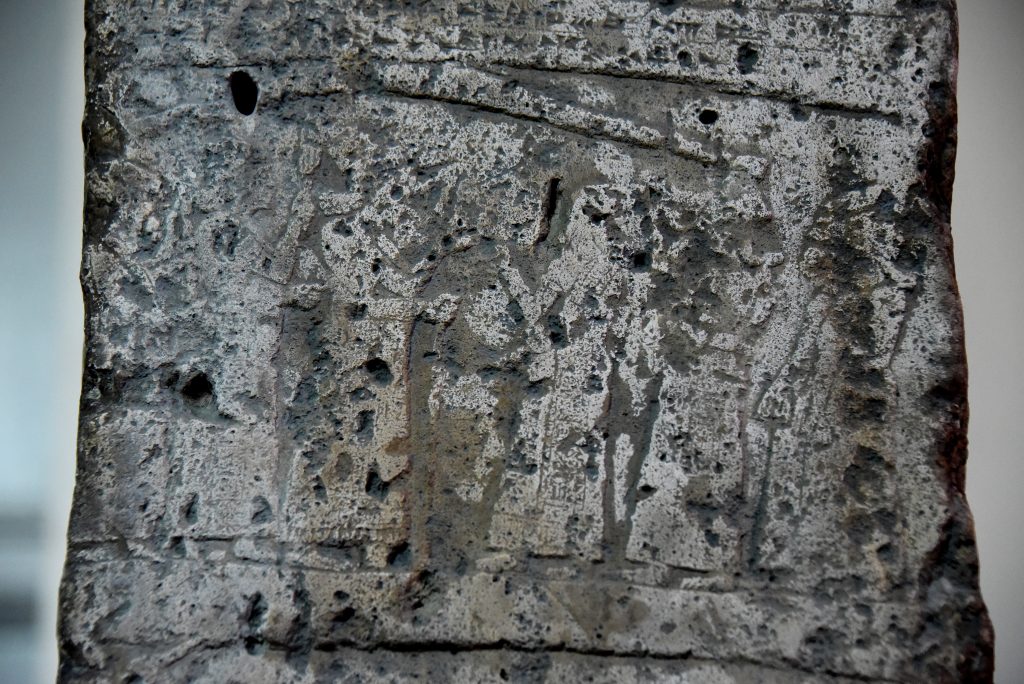
Frame 4D: Three ranks of dignitaries approach a figure of the King (to the left of this image). The King stands under a baldachin. Detail of the White Obelisk of Ashurnasirpal I. Assyrian, probably about 1050 BCE. From Mesopotamia, Nineveh (modern-day Mosul Governorate, Iraq), between the palace of Sennacherib and the Ishtar temple. The British Museum, London. Photo © Osama S. M. Amin.
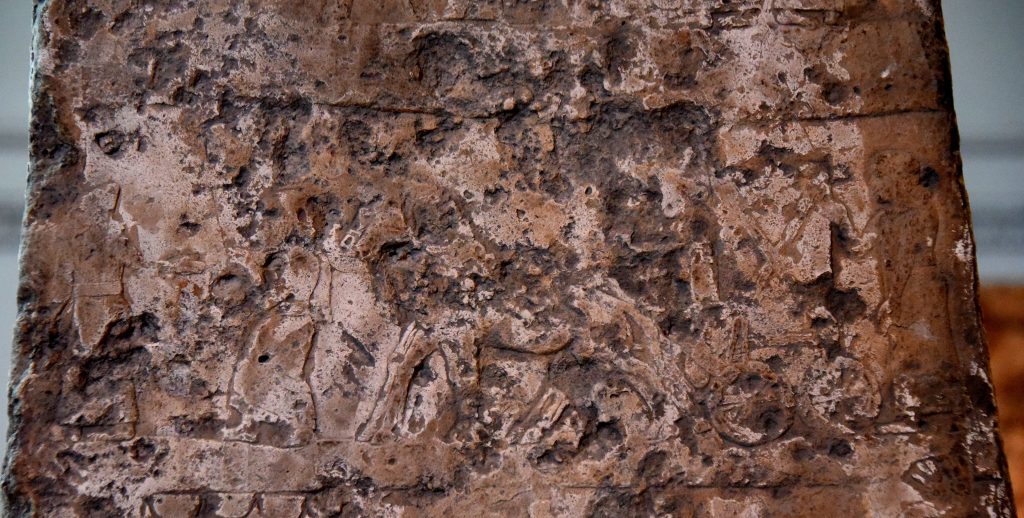
Frame 4A: Frames 4A, 4B, and 4C should be combined to understand the remaining part of the scene. Gesturing right to the procession, a man leads an enemy figure preceding a horse-drawn wagon (this is seen in this image). Behind them, we can find 6 ranks of men carrying goods. The latter group is followed by three ranks of horses driven by a single man. The bodies of the leading horses were divided between frames 4B and 4C. Detail of the White Obelisk of Ashurnasirpal I. Assyrian, probably about 1050 BCE. From Mesopotamia, Nineveh (modern-day Mosul Governorate, Iraq), between the palace of Sennacherib and the Ishtar temple. The British Museum, London. Photo © Osama S. M. Amin.
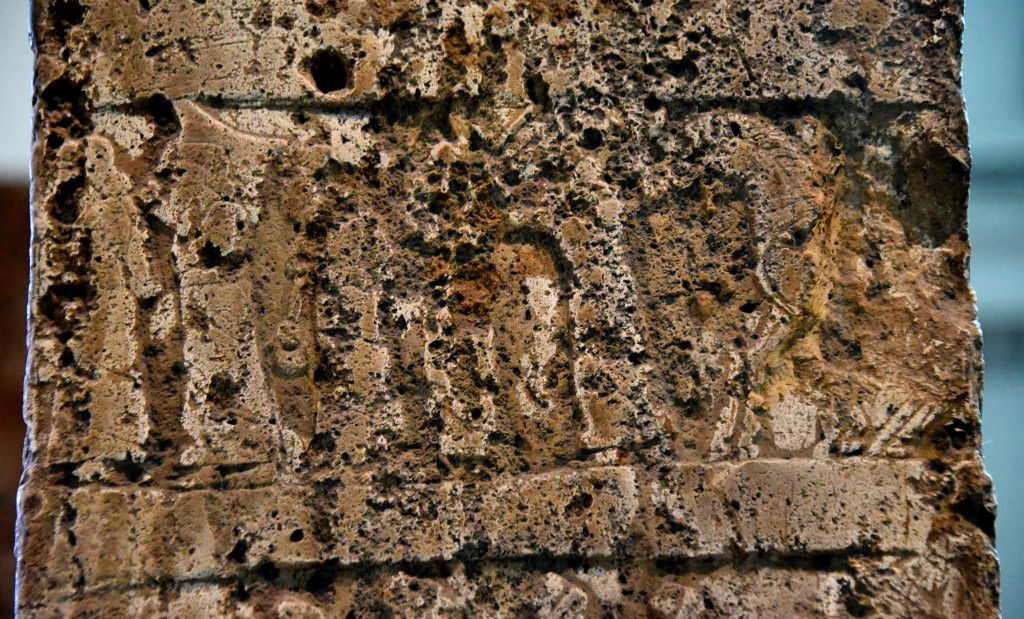
Frame 4B: Frames 4A, 4B, and 4C should be combined to understand the remaining part of the scene. Gesturing right to the procession, a man leads an enemy figure preceding a horse-drawn wagon. Behind them, we can find 6 ranks of men carrying goods (in this image). The latter group is followed by three ranks of horses driven by a single man. The bodies of the leading horses were divided between frames 4B (can be seen on the far right in this image) and 4C. Detail of the White Obelisk of Ashurnasirpal I. Assyrian, probably about 1050 BCE. From Mesopotamia, Nineveh (modern-day Mosul Governorate, Iraq), between the palace of Sennacherib and the Ishtar temple. The British Museum, London. Photo © Osama S. M. Amin.
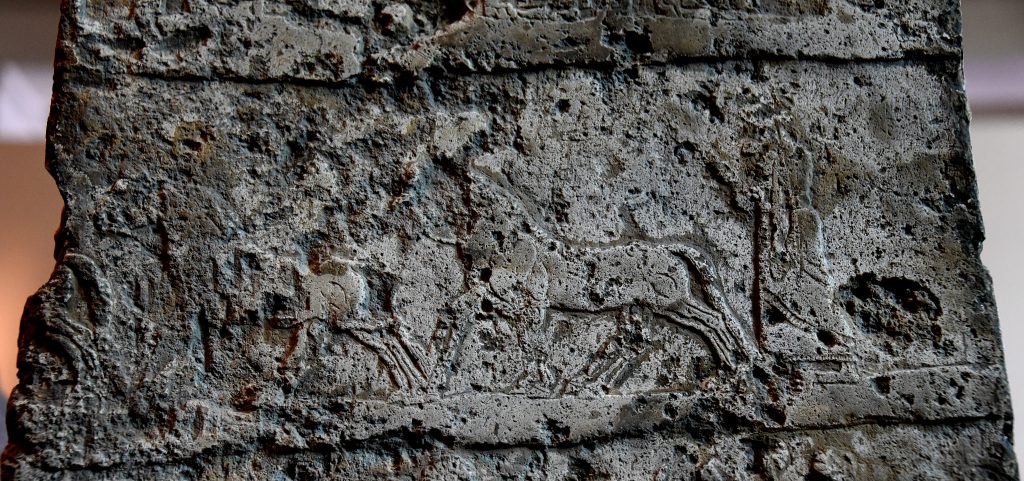
Frame 4A: Frames 4A, 4B, and 4C should be combined to understand the remaining part of the scene. Gesturing right to the procession, a man leads an enemy figure preceding a horse-drawn wagon. Behind them, we can find 6 ranks of men carrying goods. The latter group is followed by three ranks of horses driven by a single man (seen in this image). The bodies of the leading horses were divided between frames 4B and 4C. Detail of the White Obelisk of Ashurnasirpal I. Assyrian, probably about 1050 BCE. From Mesopotamia, Nineveh (modern-day Mosul Governorate, Iraq), between the palace of Sennacherib and the Ishtar temple. The British Museum, London. Photo © Osama S. M. Amin.
Register 5: Once again, the whole scene in one episode extends over four frames. However, the movement in this register starts from left and proceeds to the right. The scene starts from frame 5C and ends in 5B (at the king).

Frame 5C: The overall organization as well as the core subject of this register repeat those of register 4. Frames 5A, 5B, 5C, and 5D form the whole scene. The King stands and 4 ranks of individuals approach the King. Those men are followed by an enemy figure and a horse-drawn wagon. The latter precedes (exactly as in register 4), a group of men carrying booty and goods. Following them, are two horses, a horse driver, and 2 bulls. There is a herdsman bringing up the rear (shown in this image). The location is marked by 2 three-stemmed plants. Detail of the White Obelisk of Ashurnasirpal I. Assyrian, probably about 1050 BCE. From Mesopotamia, Nineveh (modern-day Mosul Governorate, Iraq), between the palace of Sennacherib and the Ishtar temple. The British Museum, London. Photo © Osama S. M. Amin.
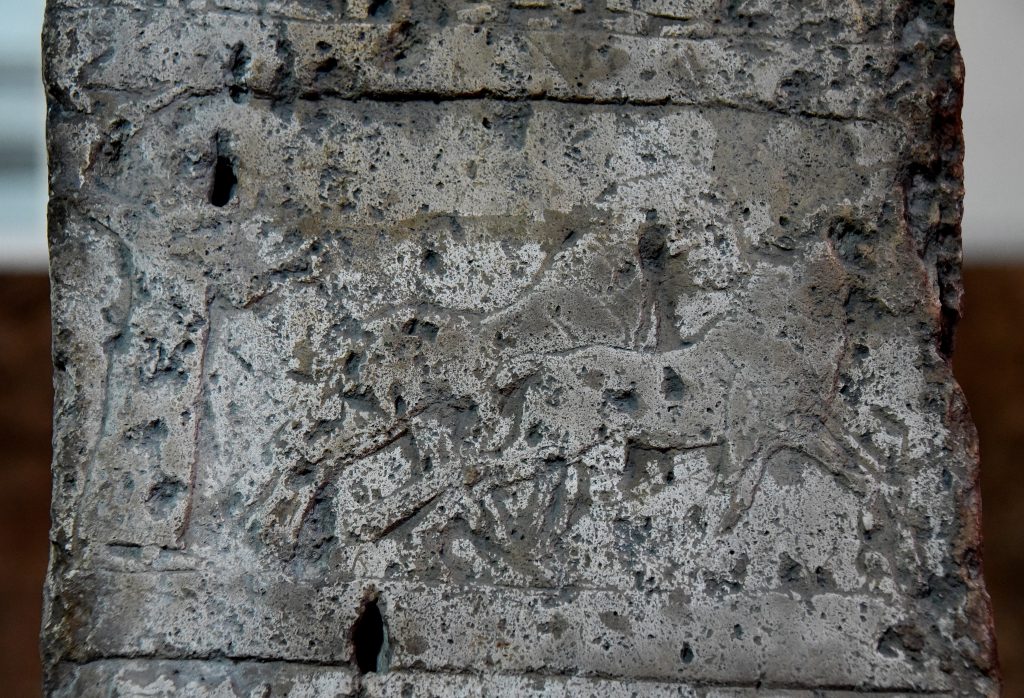
Frame 5D: The overall organization as well as the core subject of this register repeat those of register 4. Frames 5A, 5B, 5C, and 5D form the whole scene. The King stands and 4 ranks of individuals approach the King. Those men are followed by an enemy figure and a horse-drawn wagon. The latter precedes (exactly as in register 4), a group of men carrying booty and goods. Following them, are two horses, a horse driver (in this image, the 2 horses and the driver appear), and 2 bulls. There is a herdsman bringing up the rear. The location is marked by 2 three-stemmed plants. Detail of the White Obelisk of Ashurnasirpal I. Assyrian, probably about 1050 BCE. From Mesopotamia, Nineveh (modern-day Mosul Governorate, Iraq), between the palace of Sennacherib and the Ishtar temple. The British Museum, London. Photo © Osama S. M. Amin.
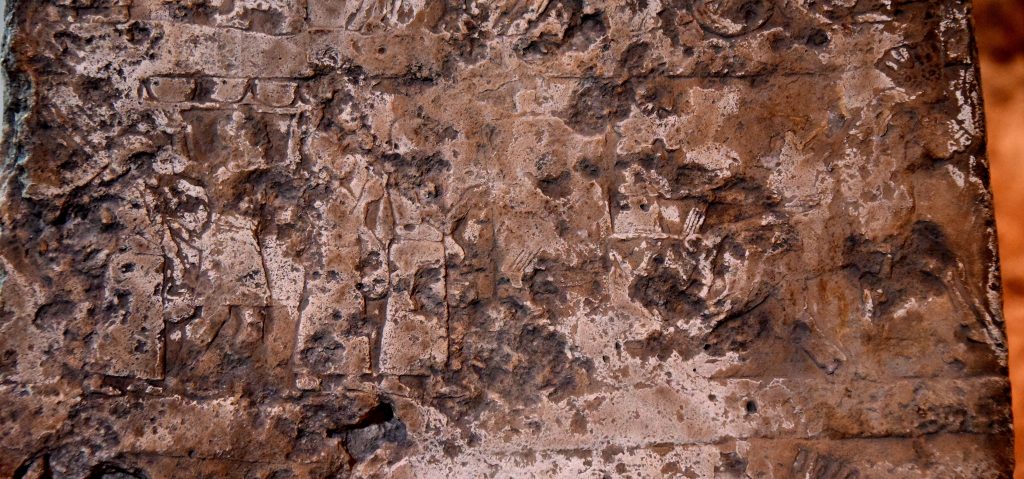
Frame 5A: The overall organization as well as the core subject of this register repeat those of register 4. Frames 5A, 5B, 5C, and 5D form the whole scene. The King stands and 4 ranks of individuals approach the King. Those men are followed by an enemy figure and a horse-drawn wagon (shown in this image). The latter precedes (exactly as in register 4), a group of men carrying booty and goods. Following them, are two horses, a horse driver, and 2 bulls. There is a herdsman bringing up the rear. The location is marked by 2 three-stemmed plants. Detail of the White Obelisk of Ashurnasirpal I. Assyrian, probably about 1050 BCE. From Mesopotamia, Nineveh (modern-day Mosul Governorate, Iraq), between the palace of Sennacherib and the Ishtar temple. The British Museum, London. Photo © Osama S. M. Amin.
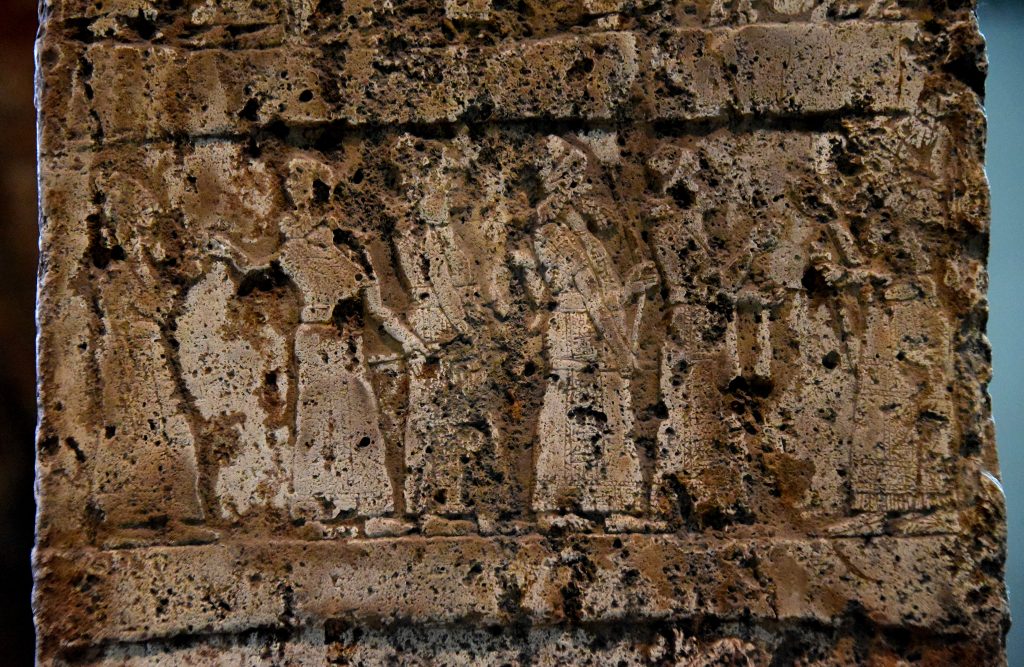
Frame 5B: The overall organization as well as the core subject of this register repeat those of register 4. Frames 5A, 5B, 5C, and 5D formulate this scene. The King stands (in this frame 5B, to the far right) and 4 ranks of individuals approach the King. Those men are followed by an enemy figure and a horse-drawn wagon. The latter precedes (exactly as in register 4), a group of men carrying booty and goods. Following them, are two horses, a horse driver, and 2 bulls. There is a herdsman bringing up the rear. The location is marked by 2 three-stemmed plants. Detail of the White Obelisk of Ashurnasirpal I. Assyrian, probably about 1050 BCE. From Mesopotamia, Nineveh (modern-day Mosul Governorate, Iraq), between the palace of Sennacherib and the Ishtar temple. The British Museum, London. Photo © Osama S. M. Amin.
Register 6: There are 2 scenes. One of them occupies a single frame while the other one consists of two episodes, which extend over and fill in 3 frames.
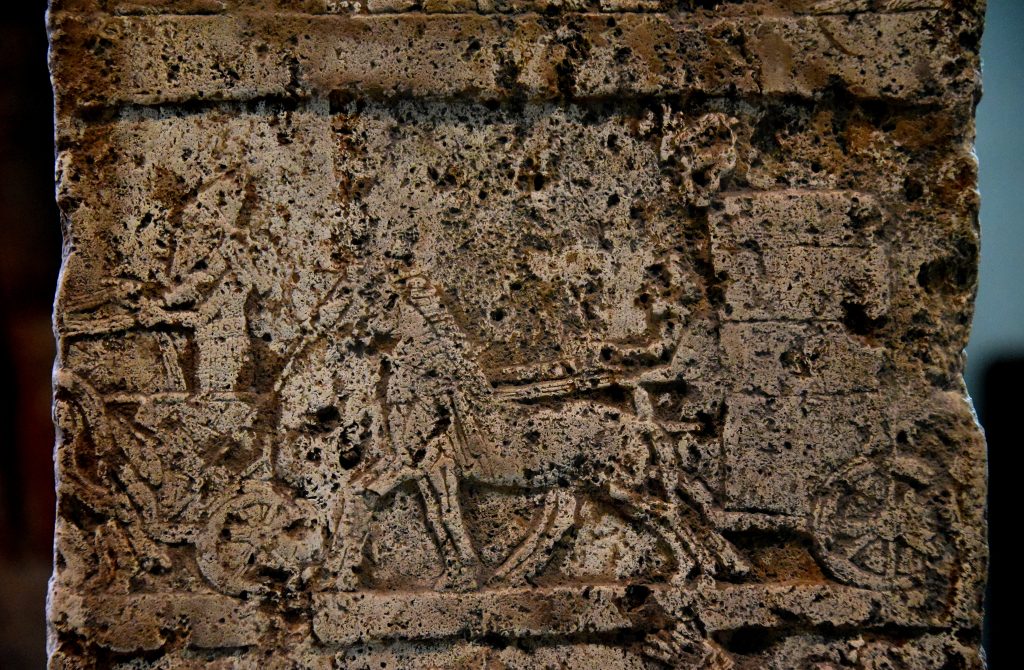
Frame 6B: Frames 6B, 6A, and 6D form one scene that is (similar to register 3) split into two adjacent and sequential episodes. The scene moves from right to left. To the right, 3 horse-drawn chariots move to the left (starting in this image), following 4 ranks of men. In this image, the 2nd chariot was divided between frames 6B and 6A. In front, the figure of the King and his courtiers walk up a hill to a city gate. Detail of the White Obelisk of Ashurnasirpal I. Assyrian, probably about 1050 BCE. From Mesopotamia, Nineveh (modern-day Mosul Governorate, Iraq), between the palace of Sennacherib and the Ishtar temple. The British Museum, London. Photo © Osama S. M. Amin.
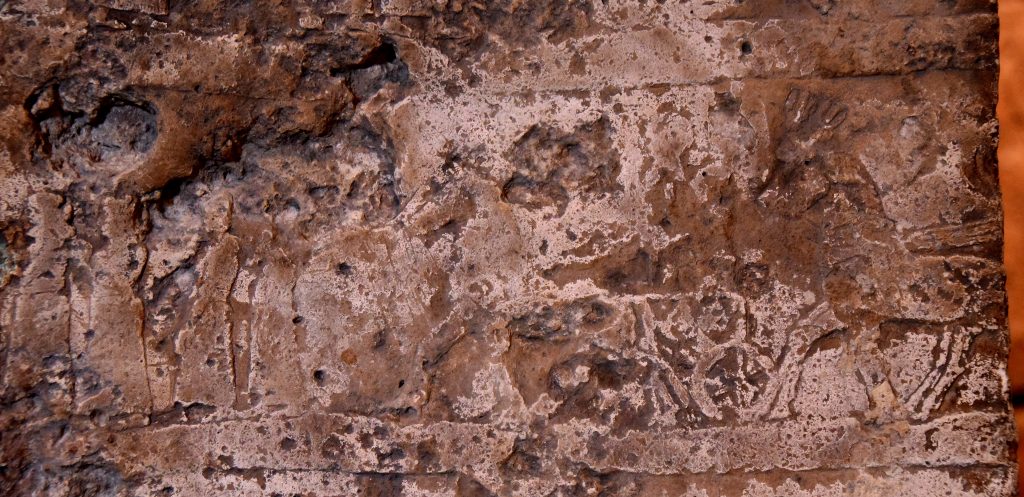
Frame 6A: Frames 6B, 6A, and 6D form one scene that is (similar to register 3) split into two adjacent and sequential episodes. The scene moves from right to left. To the right, 3 horse-drawn chariots move to the left, following 4 ranks of men (who appear in this image). The 2nd chariot was divided between frames 6B and 6A. In front, the figure of the King and his courtiers walk up a hill to a city gate. Detail of the White Obelisk of Ashurnasirpal I. Assyrian, probably about 1050 BCE. From Mesopotamia, Nineveh (modern-day Mosul Governorate, Iraq), between the palace of Sennacherib and the Ishtar temple. The British Museum, London. Photo © Osama S. M. Amin.
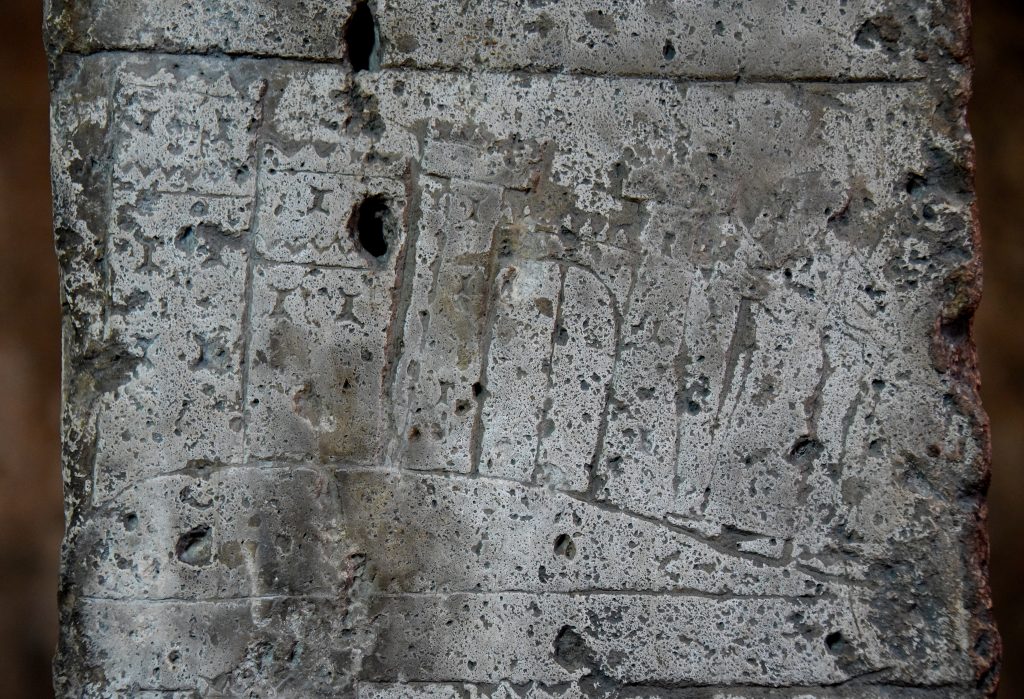
Frame 6D: Frames 6B, 6A, and 6D form one scene that is (similar to register 3) split into two adjacent and sequential episodes. The scene moves from right to left. To the right, 3 horse-drawn chariots move to the left, following 4 ranks of men. In front, the figure of the King and his courtiers walk up a hill to a city gate (shown in this image). Detail of the White Obelisk of Ashurnasirpal I. Assyrian, probably about 1050 BCE. From Mesopotamia, Nineveh (modern-day Mosul Governorate, Iraq), between the palace of Sennacherib and the Ishtar temple. The British Museum, London. Photo © Osama S. M. Amin.
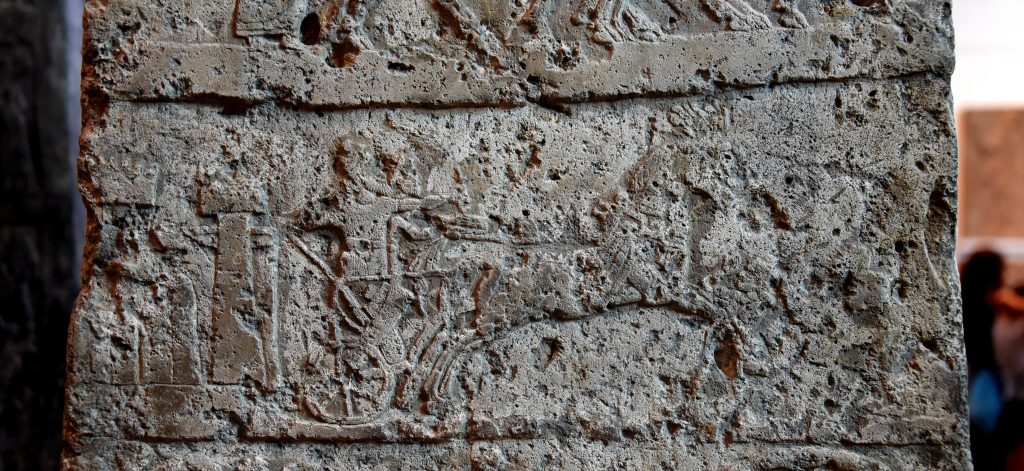
Frame 6C: This is a variation of frame 1A. It shows the King riding his royal chariot. The chariot heads away from a walled-city. Two figures appear to crouch down in fear, just before the horse of the chariot. Detail of the White Obelisk of Ashurnasirpal I. Assyrian, probably about 1050 BCE. From Mesopotamia, Nineveh (modern-day Mosul Governorate, Iraq), between the palace of Sennacherib and the Ishtar temple. The British Museum, London. Photo © Osama S. M. Amin.
Register 7: Here, we can recognize 2 scenes. Each scene is composed of 2 episodes, and in turn, each one of them extends over one-and-a-half frame.
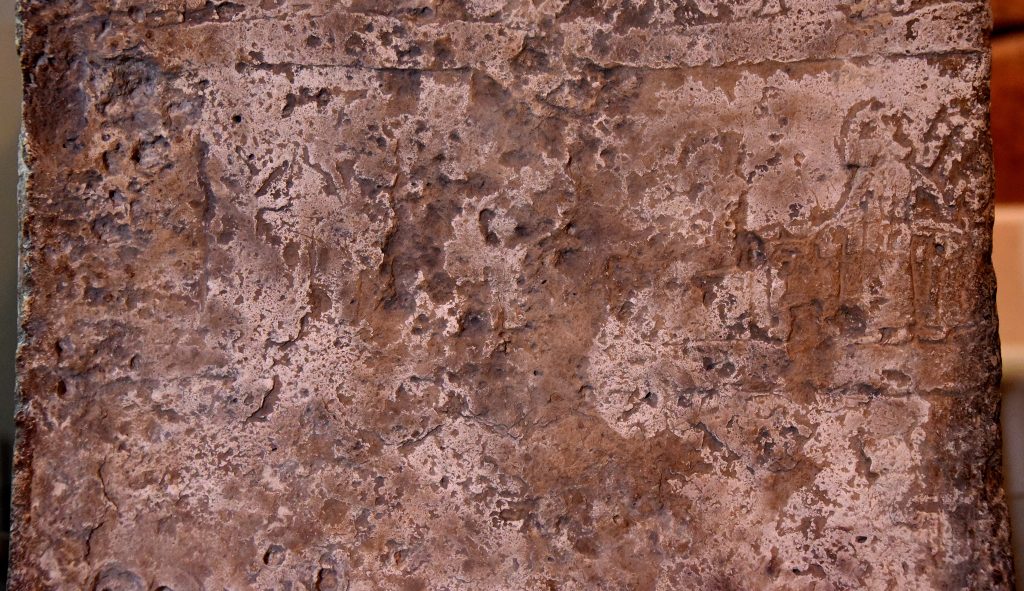
Frame 7D: Frames 7D and 7A form a single scene. This scene appears a repetition of the scene in register 3. To the right, there is a banquet (or probably a meeting); seated and standing figures were depicted on this scene (shown in this image). To the left, in frame 7D, there are laden tables. The King sits before these tables. Detail of the White Obelisk of Ashurnasirpal I. Assyrian, probably about 1050 BCE. From Mesopotamia, Nineveh (modern-day Mosul Governorate, Iraq), between the palace of Sennacherib and the Ishtar temple. The British Museum, London. Photo © Osama S. M. Amin.
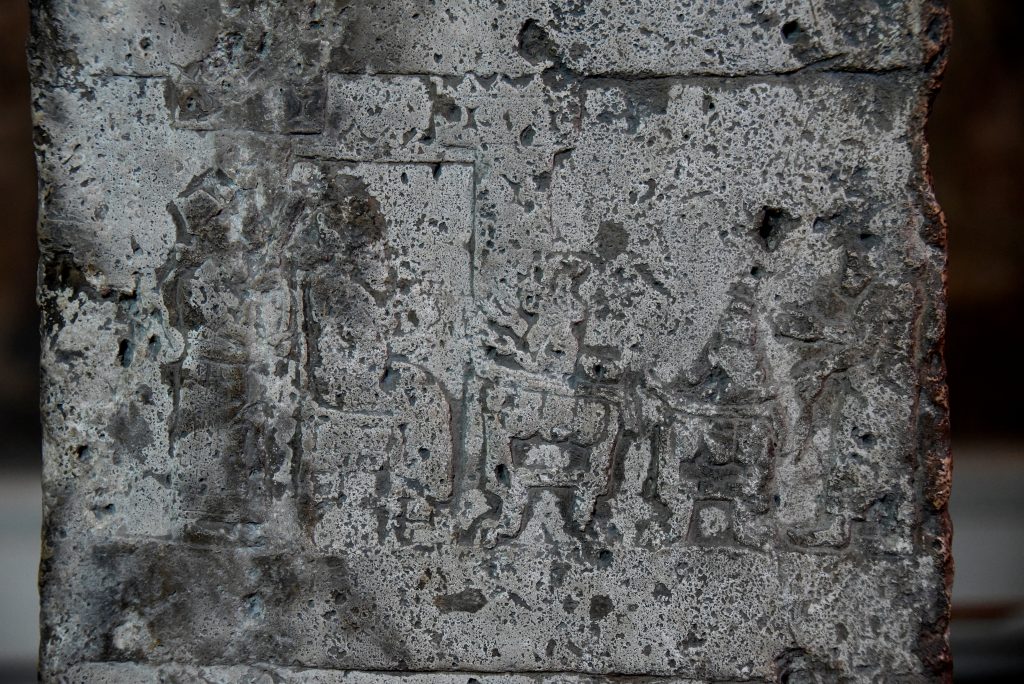
Frame 7D: Frames 7D and 7A form a single scene. This scene appears a repetition of the scene in register 3. To the right, there is a banquet (or meeting); seated and standing figures were depicted on this scene. To the left, in frame 7D, there are laden tables. The King sits before these tables (in this image). Detail of the White Obelisk of Ashurnasirpal I. Assyrian, probably about 1050 BCE. From Mesopotamia, Nineveh (modern-day Mosul Governorate, Iraq), between the palace of Sennacherib and the Ishtar temple. The British Museum, London. Photo © Osama S. M. Amin.
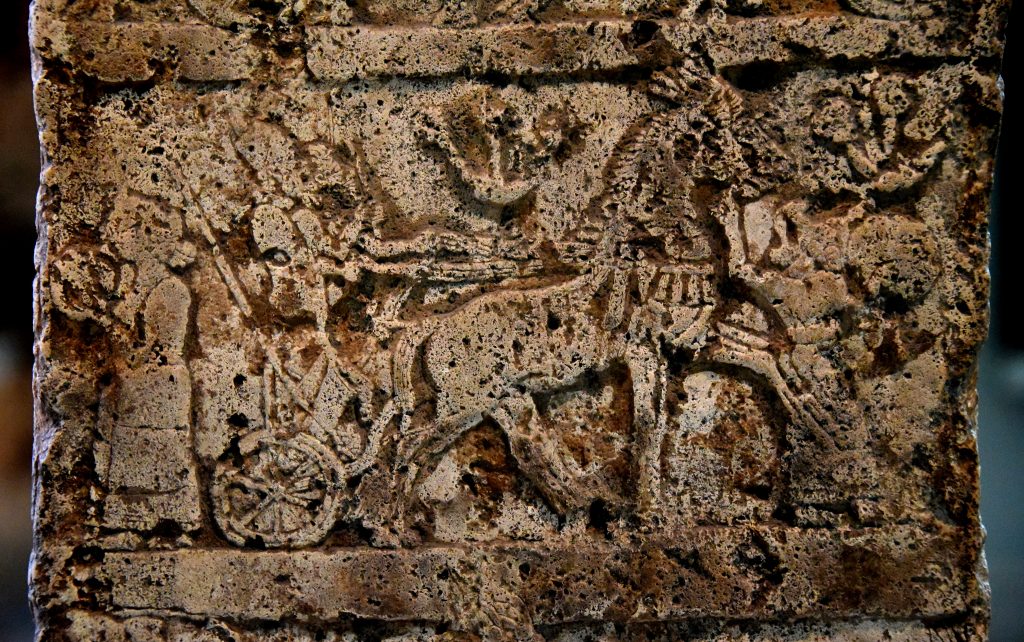
Frame 7B: Frames 7B and 7C form a single scene. The King’s chariot (in this image) moves to the right in what appears to be the same landscape of register 5. The chariot approaches a group of men walking on their feet(the men appear in frame 7C). Behind this group, we find 2 registers of sheep, a herdsman, and 2 tents. Detail of the White Obelisk of Ashurnasirpal I. Assyrian, probably about 1050 BCE. From Mesopotamia, Nineveh (modern-day Mosul Governorate, Iraq), between the palace of Sennacherib and the Ishtar temple. The British Museum, London. Photo © Osama S. M. Amin.
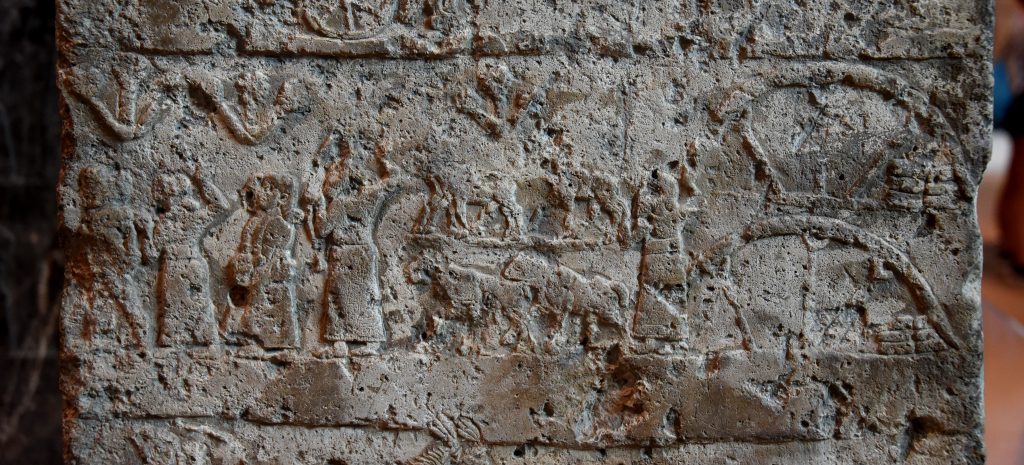
Frame 7C: Frames 7B and 7C form a single scene. The King’s chariot moves to the right in what appears to be the same landscape of register 5. The chariot approaches a group of men walking on their feet. Behind this group, we find 2 registers of sheep, a herdsman, and 2 tents (shown in this image). Detail of the White Obelisk of Ashurnasirpal I. Assyrian, probably about 1050 BCE. From Mesopotamia, Nineveh (modern-day Mosul Governorate, Iraq), between the palace of Sennacherib and the Ishtar temple. The British Museum, London. Photo © Osama S. M. Amin.
Register 8: We can recognize 4 scenes having the same arrangement of register 1.
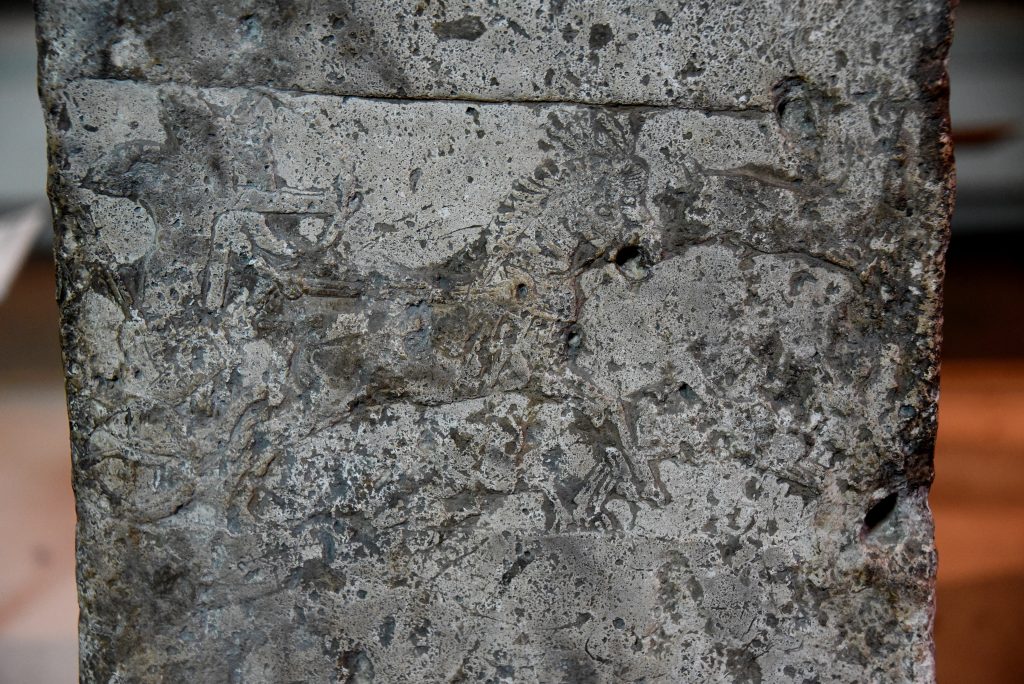
Frame 8D: The king rides a royal chariot and hunts caprids (sheep and goats). The base of the obelisk is below the scene. Detail of the White Obelisk of Ashurnasirpal I. Assyrian, probably about 1050 BCE. From Mesopotamia, Nineveh (modern-day Mosul Governorate, Iraq), between the palace of Sennacherib and the Ishtar temple. The British Museum, London. Photo © Osama S. M. Amin.

Frame 8A: Although the content of this frame is very eroded, but it perhaps shows that the King, within his royal chariot, is approaching a city. A lion was depicted behind the chariot; he is rampant and spreads his paws. Detail of the White Obelisk of Ashurnasirpal I. Assyrian, probably about 1050 BCE. From Mesopotamia, Nineveh (modern-day Mosul Governorate, Iraq), between the palace of Sennacherib and the Ishtar temple. The British Museum, London. Photo © Osama S. M. Amin.
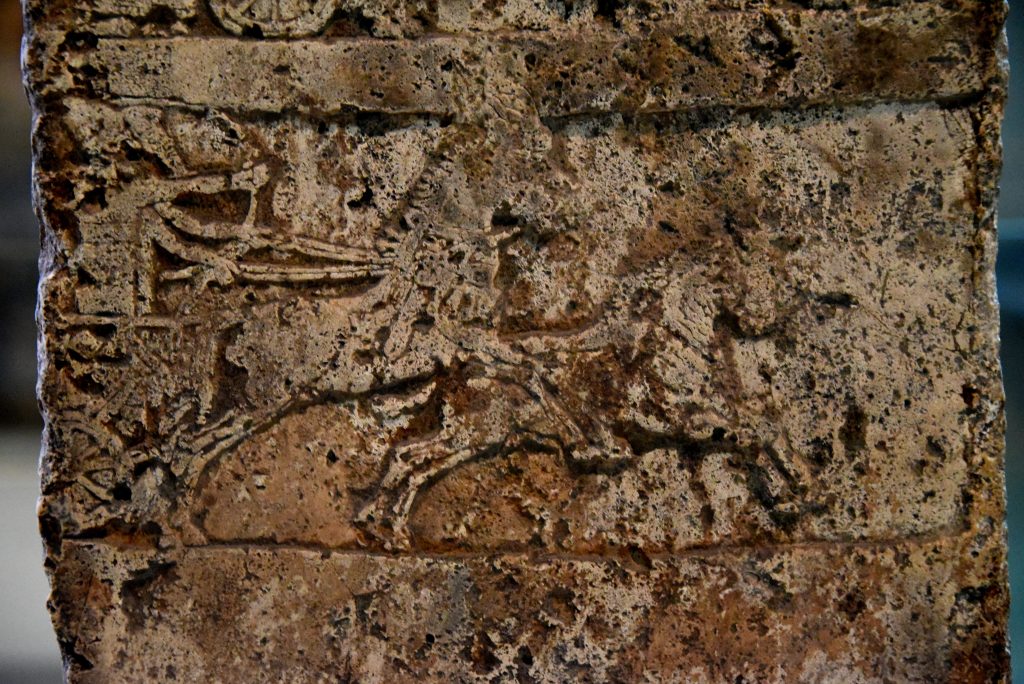
Frame 8B: The King within his royal chariot is hunting bulls. Detail of the White Obelisk of Ashurnasirpal I. Assyrian, probably about 1050 BCE. From Mesopotamia, Nineveh (modern-day Mosul Governorate, Iraq), between the palace of Sennacherib and the Ishtar temple. The British Museum, London. Photo © Osama S. M. Amin.
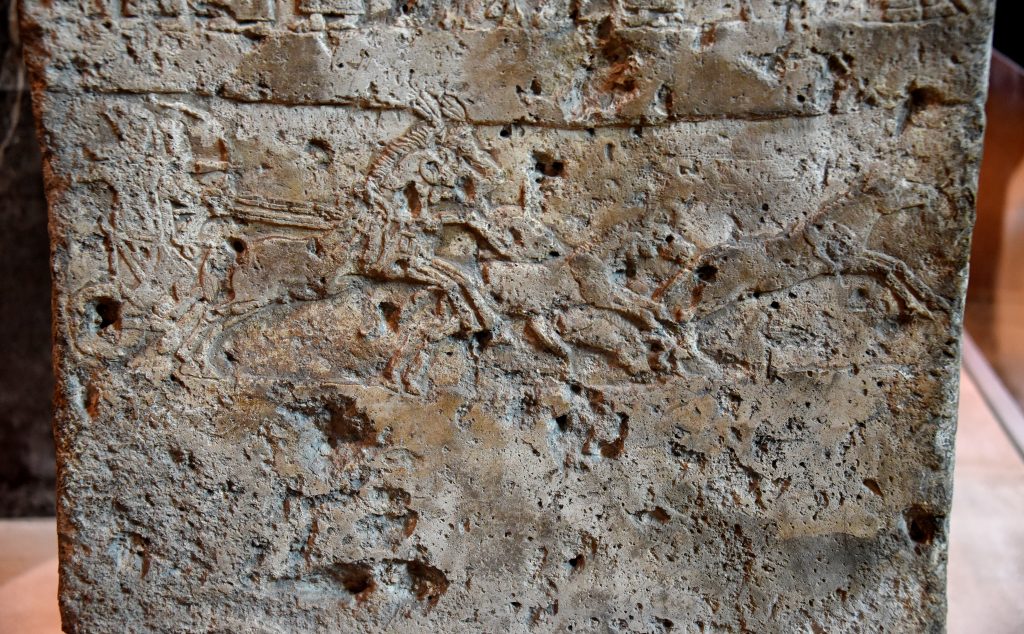
Frame 8C: From his chariot, the King hunts equids (horses, donkeys, zebras). Detail of the White Obelisk of Ashurnasirpal I. Assyrian, probably about 1050 BCE. From Mesopotamia, Nineveh (modern-day Mosul Governorate, Iraq), between the palace of Sennacherib and the Ishtar temple. The British Museum, London. Photo © Osama S. M. Amin.
The following were used in order to draft this article:
- Personal visits to the British Museum.
- The Online Collection of the British Museum.
- The White Obelisk and the problem of the historical narrative in the art of Assyria by Holly Pittman. This is a very wonderful article, with many illustrations and descriptions of the scenes.
- The White Obelisk by Edmond Sollberger. Here, you will find the transliteration of the cuneiform text, in addition to elaborate discussion on the history of the Obelisk.
After imagining the obelisk in its original standing place. I asked myself several questions: who made the carvings and how long it took to finish the obelisk? Who were the people who transferred and erected it 3000 years ago, and how many were involved? How many people saw it and understood its meaning? Why it was not deliberately vandalized/damaged after the fall of Nineveh? Why it was lying on one side when it was found; did someone push it or did it just fall down from weathering? What was the date when the obelisk had collapsed? How many years were needed for 5 meters of mud to gather on top of the obelisk?
Finally: “All what we see or seem is but a dream within a dream.” – Edgar Allan Poe. Viva Mesopotamia!
